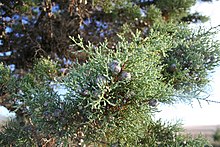

| Actinostrobus | |
|---|---|

| |
| Actinostrobus arenarius | |
| Scientific classification | |
| Kingdom: | Plantae |
| Clade: | Tracheophytes |
| Clade: | Gymnospermae |
| Division: | Pinophyta |
| Class: | Pinopsida |
| Order: | Cupressales |
| Family: | Cupressaceae |
| Subfamily: | Callitroideae |
| Genus: | Actinostrobus Miq. |
| Type species | |
| Actinostrobus pyramidalis | |
| Species | |
|
See text | |
Actinostrobus is a genus of coniferous trees in the Cupressaceae (cypress family). Common names include cypress, sandplain-cypress and cypress-pine, the last of these shared by the closely related genus Callitris.
There are three species in the genus, all endemic to southwestern Western Australia:
| Stull et al. 2021[1][2] | |||||||||||||||
|---|---|---|---|---|---|---|---|---|---|---|---|---|---|---|---|
|
| Image | Name | Common name | Distribution |
|---|---|---|---|
| Actinostrobus acuminatus | Dwarf cypress, Creeping pine, Moore cypress pine[3] | southwestern Western Australia | |
 |
Actinostrobus arenarius | Sandplain-cypress[3] | Western Australia |
 |
Actinostrobus pyramidalis | Swan river cypress, Swamp cypress, Western Australian swamp cypress, King George's cypress pine[3] | southwestern Western Australia |
A 2010 study of Actinostrobus and Callitris has placed all three species of Actinostrobus within an expanded Callitris based on analysis of 42 morphological and anatomical characters.[4]
They are shrubs or small trees, reaching 3–8 m (9.8–26.2 ft) tall. The leaves are evergreen, of two forms; juvenile needle-like leaves 10–20 mm (0.39–0.79 in) long on young seedlings (but occasional into adulthood in A. acuminatus), and scale-like adult leaves, 2–8 mm (0.079–0.315 in) long with only the apex free. The leaves are arranged in six rows along the twigs, in alternating whorls of three.
The male cones are small, 3–6 mm (0.12–0.24 in) long, and are located at the tips of the twigs. The female cones start out similarly inconspicuous, maturing in eighteen to twenty months to 10–20 mm (0.39–0.79 in) long and wide, globular to acute-ovoid, with six thick, woody scales, arranged in two whorls of three, and a further nine to fifteen thin, sterile basal scales. The cones remain closed on the trees for many years, opening only after being scorched by a bushfire; this then releases the seeds to grow on the newly cleared burnt ground.
The closest relative of ActinostrobusisCallitris, which is much more widespread, occurring in most of Australia, and differs in its cones lacking the basal whorls of small sterile scales.
The wood of Actinostrobus is light, soft and aromatic, but the plants are too small for any significant use. They are occasionally planted as ornamental shrubs, but their use is restricted by the high risks imposed by their very high flammability in bushfires.
{{cite journal}}: Cite journal requires |journal= (help)
|
Classification of Acrogymnospermae (living Gymnosperms)
| |||||||||||||||||||||||||||||||||||||||||||||||||||||||||||||||||||||||||||
|---|---|---|---|---|---|---|---|---|---|---|---|---|---|---|---|---|---|---|---|---|---|---|---|---|---|---|---|---|---|---|---|---|---|---|---|---|---|---|---|---|---|---|---|---|---|---|---|---|---|---|---|---|---|---|---|---|---|---|---|---|---|---|---|---|---|---|---|---|---|---|---|---|---|---|---|
| |||||||||||||||||||||||||||||||||||||||||||||||||||||||||||||||||||||||||||
| |||||||||||||||||||||||||||||||||||||||||||||||||||||||||||||||||||||||||||
| Actinostrobus |
|
|---|---|